© 2014-


Radio Caroline 1970’s - History (11)
Throughout this period too the number of taped American religious programmes broadcast by Radio Caroline continued to increase steadily with a total of thirty one different organisations buying airtime, providing the station with its only real source of revenue. Whilst essential financially the increased airtime allocated to these broadcasts undoubtedly had a detrimental effect on the station's audience levels -
Gales and heavy seas returned to the North Sea on 19th March 1980, but Radio Caroline's Dutch Service, now containing mostly pre-
The code numbers were, of course, meaningless to the majority of listeners but for those actually involved with the operation of the station they indicated something was seriously wrong on board the radio ship.
When the English Service of Radio Caroline started at 7.00pm none of the regular programmes were aired, just continuous music and the hourly coded messages for the office. The enormity of the problems being experienced by the crew on board the Mi Amigo only became fully apparent at midnight when Stevie Gordon and Tom Anderson came on the air to announce they were abandoning ship.
What had been happening earlier in the day was that the radio ship's anchor chain had broken at about 1.30pm and she began to drift. The crew worked for two hours to lower the emergency anchor, which they succeeded in doing, but the Mi Amigo had by then hit the edge of the Long Sand sandbank. Apart from the coded messages no announcements or pleas for assistance were broadcast to listeners and anyway the situation at that time seemed stable enough with the ship having settled firmly on the sandbank at low water, a scenario which had been experienced many times before by the Mi Amigo and her crews.
The Coastguard Service had been advised of the problem over the emergency channel and they arranged for a lifeboat to be placed on stand-
About 9.30pm, with the tide rising, the Mi Amigo was being repeatedly pounded on the sandbank in the heavy seas and Force 9 easterly gales. Without warning she started to take in a huge volume of water and for a while the crew still refused to leave the vessel, preferring instead to try and sit out the storm and hope the emergency pumps would be able to cope until a tender arrived to tow them back to their normal anchorage.
Although during her 18 years as a home to so many radio stations the Mi  Amigo had experienced countless such dramas, the situation this time deteriorated so quickly that the pumps could not cope with the volume of water cascading in through holes in her hull.
Amigo had experienced countless such dramas, the situation this time deteriorated so quickly that the pumps could not cope with the volume of water cascading in through holes in her hull.
In the end the crew had to abandon ship in such a hurry that they didn’t even have time to pack their personal belongings. The station's master tapes, which had been packed in a waterproof bag also had to be left behind. It took the lifeboat nearly an hour to get the four men and Wilson II, the ship's canary, off the sinking radio ship. The crew of the lifeboat repeatedly risked their lives in mountainous seas to successfully achieve this rescue operation.
The Mi Amigo's generator had been left running to provide power for the abandoned vessel's navigation lights, but as they headed for land the crew of the lifeboat reported seeing the radio ship's lights go out. Three hours later the rescued crew were landed at Sheerness and interviewed by police, acting on instructions from the Home Office. Police later announced that the DJs would not face prosecution.
At first light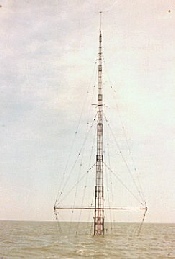 on 20th March 1980 an RAF helicopter flew over the area and reported that the Mi Amigo had sunk, with only some superstructure and the 134' aerial mast remaining above water. Within a few days Trinity House had marked the wreck with buoys and issued an official warning to shipping in the area.
on 20th March 1980 an RAF helicopter flew over the area and reported that the Mi Amigo had sunk, with only some superstructure and the 134' aerial mast remaining above water. Within a few days Trinity House had marked the wreck with buoys and issued an official warning to shipping in the area.
Almost immediately after the sinking plans were announced to try and re-
Plans to attempt a salvage operation were soon shelved, however, when divers inspected the wreck only a matter of weeks after the sinking. It was discovered that the ship had settled firmly on the bottom of the sea-
Almost as soon as the Mi Amigo had sunk representatives of Radio Caroline were stating publicly that the station would return to the air from another vessel and it was reported that the station's backers had been looking for a new ship anyway, even before the Mi Amigo had gone dow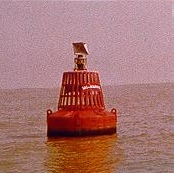 n. However, the money to purchase a replacement vessel was not available, or forthcoming, and the plans were shelved. A new ship was eventually found, as was financial backing, and Radio Caroline returned to the airwaves in 1983 -
n. However, the money to purchase a replacement vessel was not available, or forthcoming, and the plans were shelved. A new ship was eventually found, as was financial backing, and Radio Caroline returned to the airwaves in 1983 -

Abandoning ship announcement March 1980

Coded announcements for the office on land

Above: Only the mast remained visible after the Mi Amigo sank in March 1980
Below: a Trinity House buoy marks the wreck of the Mi Amigo
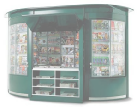

Click on picture to enlarge
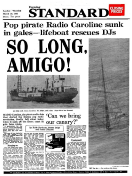
Evening Standard
20th March 1980
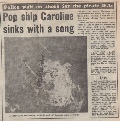
Daily Mail
21st March 1980
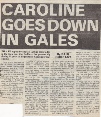
Ipswich Evening Star
20th March 1980

Daily Mirror
21st March 1980

Daily Telegraph
21st March 1980
Later in 1980 the British advertising trade magazine, Campaign, used the sinking of the Mi Amigo and the consequent temporary closure of Radio Caroline in a promotion for its forthcoming feature on commercial radio
Click to enlarge

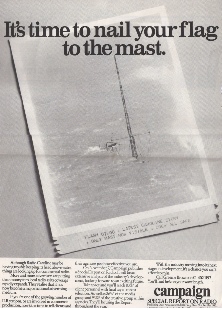

History
Key Dates
Ships and Location
Technical
Staff
Programmes





Caroline DJ Tom Anderson remembers the Mi Amigo sinking.
Caroline DJ Tom Anderson visits the site of the Mi Amigo wreck in an episode of the BBC TV Coast programme, 2010.
Treasure Chest

Artist’s impression of the lifeboat rescuing crew members from the Mi Amigo

Click image to enlarge
A video showing 3D images of the Mi Amigo wreck
Television news reports of the Mi Amigo sinking.
(ITN, BBC, Anglia TV)





Back to Britain Gallery


Back to Netherlands/Belgium Gallery

Back to Radio Caroline 1970s